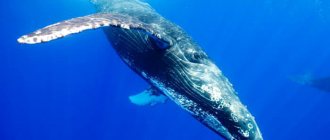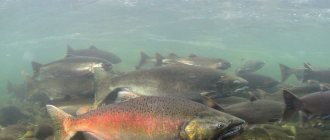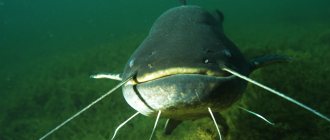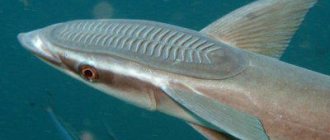Representatives of the class of mammals - whales - are marine animals that amaze with their impressive size. In Greek, the meaning of the word kitoc is “sea monster”, from which the name of this mammal comes from. In the old days, when fishermen just began to notice such a large creature as a whale, there were frequent disputes about whether it was a fish or an animal. Surprisingly, the ancestors of all cetaceans are artiodactyl land animals. Although the whale looks like a fish in appearance, one of its modern ancestors is a hippopotamus. Currently, there is no longer any doubt that whales are marine mammals.
Whale - description and characteristics
The size of whales exceeds the dimensions of any mammal: the body length of a blue whale reaches twenty-five to thirty-three meters, its weight is more than one hundred and fifty tons. But there are also smaller, dwarf whales. Their weight does not exceed four tons, and their body length is six meters.
Whale structure
All cetaceans have a body shaped like an elongated drop, which allows them to glide easily in the water column. The large head with a narrow and blunt rostrum allows the whale to cut through the water when swimming. The nostrils are shifted closer to the crown, and the eyes are small relative to the body. Different individuals have differences in the structure of their teeth. Toothed whales have sharp cone-shaped teeth, and baleen whales, instead of the usual teeth, filter water and thus obtain food using bone plates (or whalebone).
The whale's skeleton provides special plasticity and the ability to perform maneuvers due to the spongy structure and elasticity of the intervertebral discs. The head goes into the body without a neck interception; towards the tail the body becomes narrower. The mammal turns and slows down with the help of flippers, which have been transformed from pectoral fins. The motor function is performed by the tail, which is distinguished by its flat shape, extreme flexibility and developed muscles. At the end of the tail section there are horizontally arranged blades. Many whales use their tail to stabilize their movements underwater.
Hairs and bristles grow only on the faces of baleen whales; the body is covered with absolutely smooth and hairless skin. The color of the animal's skin can be monochromatic, anti-shadow - dark top and light bottom, or spotted. As whales age, they can change the color of their skin. Cetaceans lack olfactory receptors and also have poorly developed taste receptors. The whale can only distinguish the taste of salty foods, while other mammals have a full range of taste buds. Poor vision and frequent myopia are fully compensated by the conjunctival glands. Mammalian hearing distinguishes sounds ranging from muffled noises to ultrasonic frequencies, due to the complex anatomical structure of the inner ear. There are a large number of nerves under the skin, which provides the animal with an excellent sense of touch.
Whales communicate with each other using echolocation. The absence of vocal cords did not prevent the whale from communicating with other individuals by producing sounds. The role of a reflector and a sound lens is performed by a layer of fat in the concave bones of the skull. Whales have slow, smooth movements, but sometimes their speed can reach forty kilometers per hour.
The body temperature of a whale does not depend on the environment; these are warm-blooded animals. A thick layer of fat protects cetaceans from hypothermia. Huge lungs with well-developed muscles allow animals to spend under water from ten minutes to an hour and a half. Swimming to the surface of the ocean, the whale releases air whose temperature is much higher than the surrounding air. That is why, when exhaling, a fountain appears - a sheaf of condensate, and along with it, due to the high power, a trumpet roar breaks out in some large animals.
Natural enemies
Although vomits are the largest mammals, and they have enemies. They are attacked by pods of killer whales. Young or sick individuals most often become victims. If predators try to attack a healthy adult whale, they will suffer - the difference in body weight is so great.
Killer whales have to gather in groups of dozens in order to achieve at least some result. Predators drive the prey into the thickness of the sea water, then the vomit cannot get to the surface and take a breath. Gradually the mammal weakens and resists sluggishly. Killer whales attack from different sides, tear off pieces of his body, and try to get to the main delicacy - the tongue.
But even predators do not cause as much damage to the puking population as humans do. From one adult individual a person can get about 25 tons of valuable fat and a significant amount of baleen, from which brushes, corsets, carriage bodies, and chairs are made. And blue whale meat is also in demand due to its high taste.
After the invention of the harpoon cannon, the number of puke hunters increased. First they exterminated the humpback whale, and then switched to the blue one. It was only in 1966 that industrial hunting of the mammal was banned.
Where do whales live?
The habitat of whales is the world's oceans. Mammals are scattered across all latitudes, but in cold weather most migrate to warm waters and live near the coast. These are herd animals that prefer to live in groups with several dozen or hundreds of individuals. Whales migrate depending on the season. In winter and during the birthing period, whales and their females swim to warm waters, and in summer they are in waters of temperate or high latitudes.
What do whales eat?
A whale's diet depends on its species. Plankton is preferred by planktivores; mollusks act as food for teutophages. Ichthyophages feed on live fish; detritivores consume decomposed organic matter. Killer whales are the only cetaceans that hunt not only fish, but also pinnipeds such as seals, penguins and sea lions. Dolphins and their offspring can also become victims of killer whales.
What does it eat?
The diet of animals directly depends on the habitat and the season of the year. Each species also prefers to feed on a variety of “dishes,” which exist in large quantities in various bodies of water around the globe. The basis of the diet is zooplankton, small crustaceans and mollusks, which planktivorous bowhead whales eat while swimming near the surface of the water. Their brothers - gray whales, which are benthophages, prefer to submerge slightly in the water, and ichthyophages prefer to hunt schools of fish. Striped whales feed on a variety of living organisms - crustaceans, mollusks and even fish.
Due to the constant and cyclical change of seasons, animals of this species prefer to store a fat layer. This always happens in late autumn, and in winter the fat is gradually used up to maintain activity, and by spring the cetaceans regain their slender shape. During reproduction, a number of species do not eat food at all.
Types of whales
Blue whale
The largest representative of the mammal family is the blue whale. One hundred and fifty tons of weight and a length of thirty meters give the blue whale the right to be considered the largest animal on the planet. The narrow head and slender body allow the mammal to move smoothly under water, cutting through its thickness. The skin has the appearance of marble stone thanks to the gray spots scattered throughout the blue body of the whale. The blue whale lives in every ocean and feeds mainly on plankton and small fish. Blue whales prefer to live and move alone. The size of the blue whale attracts poachers and scientists to it.
The blue whale dives into deep water in moments of fear or injury. Whalers, using harpoons, measured the maximum depth to which the animal descends - five hundred and forty meters, although during a normal dive a whale does not descend into water deeper than one hundred meters. After a deep dive, the mammal makes a series of surfacings in order to inhale air. The length of the blue whale makes it dive and emerge rather slowly. The animal spends three quarters of its life under water. The blue whale reproduces more slowly than other cetaceans: calves are born no more than once every two years. During one birth, only one baby is born, and the pregnancy period itself is very protracted.
The animals were practically exterminated in the last century, so now scientists are trying to increase their numbers. Today, the number of blue whales across the planet does not exceed ten thousand individuals. Poachers destroy blue whales because of the value of their baleen. It has a rich pitch black color and a triangular shape. The fringe located on the baleen plates allows the whale to feed on large crustaceans and small plankton.
The songs of an animal like the blue whale are considered very depressing. The blue whale lives about eighty to ninety years, the maximum recorded age of the animal is one hundred and ten years.
Humpback whale
Because of the convex hump-shaped fin on the back, one of the whale representatives was called humpback. The animal has a short body - at least fourteen meters, while its mass is about thirty tons. The humpback whale differs from other species in the form of a variety of skin colors and the presence of several rows of warty, leathery growths on the top of the head. The body color of the mammal can vary from brown to dark gray and black, the chest and belly are covered with white spots. The upper part of the fins can be completely black or covered with light spots, the bottom is completely white. The animal has long pectoral fins, the mass of which makes up a third of the whale's total weight. Humpback whales have individual growths as well as coloration.
This mammal lives in the waters of all oceans, excluding the areas of Antarctica and the Arctic. Migration of the humpback whale can be either localized or seasonal, depending on the availability of food or ocean water temperature. Animals do not choose specific areas to live, but prefer to be near the shore, in shallow water. During the migration period, whales enter deep waters, but usually stay near the shores. At this time, mammals hardly eat, feeding on reserves of subcutaneous fat. Crustaceans, mollusks and small fish make up the diet of the humpback whale in the warm season. Groups of these animals quickly disintegrate. Only mothers and cubs can swim and hunt together for long periods of time.
The humpback whale is known for the sounds it makes. During the breeding season, males make long-lasting sounds, reminiscent of melodic songs, attracting females. Scientists who became interested in these sounds, through research, were able to determine that the songs of the humpback whale, like human speech, consist of individual words that form sentences.
Humpback whales rarely live to be fifty years old, although these animals have practically no natural enemies. Sometimes killer whales can attack whales, but they are more susceptible to external parasites due to their slow movement.
Dwarf whale
The pygmy whale is considered the smallest species of cetacean. Its mass does not reach three tons, and its body length does not exceed six meters. This is the only whale that moves in waves. The dwarf whale has a streamlined body with a gray or black color with gray spots. The animal’s head is completely free of any growths, the pectoral fins are very short, have a rounded shape, and the sickle-shaped dorsal fin does not exceed twenty-five centimeters in height. Unlike blue, the dwarf whale has a white baleen with a yellowish tint.
Scientists provide little information about the lifestyle of this animal, as it is rare. The dwarf whale does not jump out of the water and does not raise its tail fin above its surface. The fountains that he releases when exhaling are not striking in their size and are not accompanied by a hum. The mammal can be distinguished by its light gums and a white spot on its jaw. The dwarf whale swims rather slowly, bending its body in waves.
The mammal leads a solitary lifestyle, but sometimes it can be seen in groups of sei whales or minke whales.
These whales are rarely found in the open ocean; they often swim in shallow bays. During the warm season, young pygmy whales move to coastal waters. Animals do not migrate long distances. Plankton, crustaceans, and invertebrate marine animals act as food for dwarf whales. This is the rarest and smallest species of cetacean.
Beluga whale
One of the representatives of cetacean mammals is the beluga whale. The name of the animal comes from its color. Beluga whale calves are born with dark blue skin, which then changes to light gray, and adults are pure white. The animal is distinguished by a small head with a high forehead. The beluga whale can turn its head because its cervical vertebrae are not fused. Most whales do not have this ability. The animal has no dorsal fin, and the small pectoral fins are oval in shape. Because of these features, the name of the mammal is translated from Latin as “wingless dolphin.” Thirty to forty years is how long these whales live.
These whales live in Arctic latitudes, but migrate seasonally. Beluga whales spend summer and spring off the coast, in areas for molting and feeding. During the molting season, whales rub in shallow water against sea pebbles, thus trying to shed their old skin. Every year the beluga whale visits the same places, remembering the place of its birth, where it returns after wintering. In winter, whales live in glaciated zones, breaking through thin ice with their powerful backs. But at moments when ice holes are covered with a thick layer of ice, beluga whales can become captured by ice. The danger comes from polar bears and killer whales, for which beluga whales can become food. Whale migration takes place in two groups: one contains several females with calves, the second contains adult males. Communication between individuals is carried out using sound signals and clapping of fins in the water. During the study of beluga whales, more than fifty types of sounds that it makes were counted.
Mating of whales takes place on the coast, several times a year. Males can organize tournament fights for a female. During birth, one baby whale appears, which the female feeds for one and a half to two years.
Sperm whale
One of the brightest cetaceans is the sperm whale. Unlike other whales, sperm whales prefer a gregarious lifestyle, moving and hunting in groups of hundreds of individuals. Their speed does not allow sperm whales to move quickly through the water column. The sperm whale is known for its ability to dive deep underwater and stay at depth for a long time. The large content of fat and fluids in the sperm whale's body provides it with protection from water pressure. The mammal stores its air supply in the air sac and muscles containing a large amount of myoglobin. In rare cases, the animal has caused accidents with deep-sea cables. The sperm whale got entangled in the cable with its tail and lower jaw and choked, this was discovered already during the repair of the cable. A sperm whale was recovered off the coast of the Iberian Peninsula after it became entangled in a cable located at a depth of more than two thousand meters. At the same time, the whale uses echolocation, emitting ultrasound, which not only allows it to communicate with other sperm whales, but also to scare away dangerous animals. High-frequency signals block the movements of other ocean inhabitants, which makes it easier for the sperm whale to hunt them.
This mammal has been exterminated for several centuries, which is why its numbers have sharply declined. In conditions of polluted ocean waters and continued fishing, sperm whales are very slowly restoring their population. When wounded and attacked, the animal shows great aggression, so hunting it involves great risk. A wounded sperm whale is capable of sinking a whaling ship along with its entire crew. What does a whale eat? It eats small crustaceans, mollusks, squid, octopuses, and small sharks. To grind food, the sperm whale swallows small stones. This whale is the only mammal in whose mouth a person can completely fit. During whaling ship accidents, sperm whales swallowed whalers.
Killer whales
Many researchers are still arguing about whether the killer whale is a whale or a dolphin. Although the killer whale is called a killer whale in the media and in the everyday life of whalers, this animal belongs to the dolphins. This animal is confused with a whale because of the shape of the fin: dolphins have sharp, long fins, while killer whales have rounded and wide fins.
Kola Peninsula
Water area of the Barents Sea
To feast on fish in May, during the spawning season, cod, sperm whales and minke whales swim into the waters of the Barents Sea. This is one of the most accessible whale watching destinations in Russia.
Three-day tours to the Kola Peninsula to whale feeding areas are organized by several travel companies, including Russia Discover. The program includes a trip to the island of Kildin, fishing, a visit to Teriberka, where the action of the film “Leviathan” took place, as well as a tour of Murmansk and a visit to the nuclear icebreaker “Lenin”. The journey takes place by ship and partly by jeep.
View this post on Instagram
Posted by RussiaDiscovery (@russiadiscovery)2 Apr 2022 at 7:47 PDT
How to see the tundra: ideas and routes
Sperm whales are easily recognized by their characteristic appearance; they have a huge rectangular head, which contains the so-called spermaceti sac. According to one version, the whale uses this device for echolocation. According to another version, the bag plays the role of a swim bladder and helps the whale when diving and rising from the depths. Minke whales can be easily identified by their dozens of characteristic stripes and folds. They stretch along the lower part of the body from the mouth to the navel.
These friendly giants are among the most ancient inhabitants of the planet. They appeared on Earth 55 million years ago - long before the first man. The ancestors of whales were land animals that moved on four limbs. Then they moved to the ocean in search of food.
Where: open sea off the coast of the Kola Peninsula, Anikeev and Kildin islands.
Whales: sperm whale, minke whale. Less common are the bowhead whale, narwhal, blue whale and highbrow bottlenose.
Season: May.
Cost: three-day tour - from 44 thousand rubles per person. On the first night, guests spend the night on the ship in a cabin. The rest of the time - in mini-hotels. An additional fee is paid for a flight to Murmansk (round trip from Moscow - about eight thousand rubles).
Mating and reproduction of whales
The whale is a monogamous animal that reproduces once every two years. The mammal fully matures by the age of twelve, but it becomes able to reproduce by the age of four. Males mate throughout the whole year, so the mating season is very long. Pregnancy depends on the species of cetacean and can take from seven to fifteen months. To give birth, females migrate to warm waters.
As a result of the birth, one whale appears, which emerges from the female with its tail first. The born baby immediately has the opportunity to move and develop independently, but it stays near its mother for some time. The baby whale is fed underwater, because whale milk has a high density and high fat content, as a result of which it does not spread in water. After finishing feeding, the cub almost doubles in size. The mother and the baby whale are accompanied by the male during the entire feeding period.











